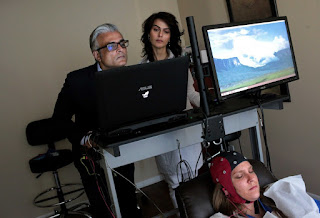You’re up on
stage, papers in hand. The lights are so bright, but all you can see is darkness.
Your heart starts to beat faster, you start to sweat, and you can feel the
crowd growing confused. They start to murmur, and you start to panic. Suddenly,
you can’t breathe. Your eyes go black. Next thing you know you’re backstage, a
sea of concerned faces staring back at you, fanning you like just fainted.
Wait, did you faint? You can’t remember. All you know is that you had another
panic attack, probably your worst one yet.
Now imagine a
world in which you could prevent those panic attacks from ever happening in the
first place. No more worrying about public speaking. No more stress. No more
anxiety. Psychiatrist Hasan Asif is attempting to do just that.
Dr. Asif has
dealt with many patients who suffer from anxiety and panic disorder, which
causes intense panic attacks that can make an individual feel almost paralyzed.
Dr. Asif’s main goal is to prevent his patients’ conditions to even get to such
an extreme level of suffering. Mental illness has been a topic of discussion
that is usually ignored in the medical world. Other illnesses that are medical
in nature seem to be at the forefront of research. However, doctors like Asif
have been working on changing that. Mental illness is unfortunately common in
today’s society, and most people who have one illness are likely to have
another.
This
comorbidity can be seen in research conducted by Shankman et al. (2013). They
noticed the comorbidity between panic disorder (PD) and major depressive
disorder (MDD), and thus explored the neural connections that might be involved
in both illnesses. They found that heightened sensitivity to threat is
characteristic of PD, and reduced sensitivity to reward is characteristic MDD.
They were able to find specific areas on the brain and neural pathways
responsible for these characteristics, which suggests that they could track
these areas for patients with PD, specifically, and possibly prevent potential
panic attacks from happening.
In the
article “The Mind’s Biology” by Amy Ellis Nutt, she explains the use of
biomarkers, which are concrete measurements of mental illness. Dr. Asif hopes
that these biomarkers will help researchers find biological clues in a
patient’s blood, saliva, or brain image that represent symptoms of certain
mental illnesses. The idea is that these biomarkers will track the symptoms of
panic disorder, for example, by manually activating those areas of the brain
and recording the patient’s responses (such as heart rate, blood pressure, breathing
rate, etc.).
 |
| Dr. Asif analyzes a patient's brain-wave activity using an EEG method (The Washington Post). |
This
innovative approach to treating mental illnesses could be the answer to problems.
By being able to tell where certain symptoms occur in the brain, psychiatrists
can treat them before they develop into something as severe as panic disorder.
Such as in the study with Shankman et al. (2013), Dr. Asif is trying to
pinpoint areas of the brain, and the neural systems involved, that are active
while these symptoms are occurring. Pretty soon, we’ll be able to stop mental
illness in its tracks.
Now, imagine
yourself back on that stage. Your heart begins to beat fast again, and your
breathing becomes shallow. “Uh oh”, you think, “it’s going to happen again.” But,
you open your mouth and words actually come out, words that make sense. You are
giving your speech, still nervous nonetheless, but the point is that you are
doing it.
Works Cited:
Study:


No comments:
Post a Comment